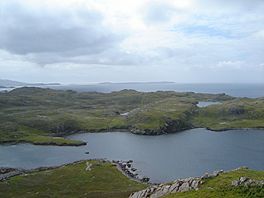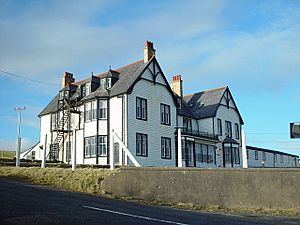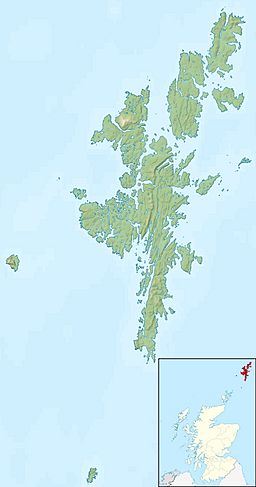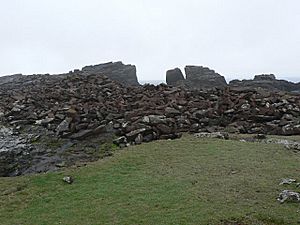St Magnus Bay facts for kids
Quick facts for kids St Magnus Bay |
|
|---|---|

Vementry with St Magnus Bay and Papa Stour beyond
|
|
| Location | Northwest of Mainland, Shetland |
| Coordinates | 60°24′N 1°36′W / 60.4°N 1.6°W |
| Type | Bay |
| Surface area | 360 km2 (140 sq mi) |
St Magnus Bay is a big bay in the northwest of Mainland Shetland, Scotland. It's shaped like a circle, about 19 kilometers (12 miles) wide. To the west, it opens up to the North Atlantic Ocean.
The coastline around the bay has many smaller bays, firths, and voes (narrow inlets). There are also several islands nearby. The water in the bay can be as deep as 165 meters (541 feet). Some people think a meteor might have hit this area a long time ago.
The rocks and land around St Magnus Bay are very interesting. You can find many caves and tall cliffs along the coast. People have lived here since ancient times. The calm inner waters of the bay have been a safe place for ships, both in times of peace and war. Shetland was part of Scandinavia until 1469. Because of this, many place names and some local traditions come from Norse (Viking) culture.
Contents
Exploring St Magnus Bay: Islands and Inlets
This section will guide you through the many islands and inlets that make up St Magnus Bay.
Islands and Reefs in the Bay
The Ve Skerries are a group of dangerous rocks in the southwest of St Magnus Bay. They are a risk to ships. About 5 kilometers (3 miles) southwest of these rocks is Papa Stour, an island where people live. Nearby are smaller islands like Brei Holm, Fogla Skerry, and Maiden Stack.
Forewick Holm and Holm of Melby are in the Sound of Papa. This sound separates Papa Stour from the mainland areas of Walls and Sandness.
Voes and Mainland Inlets
Further east, you'll find the narrow Voe of Snaraness. Then there's West Burra Firth, which has the remains of the Broch of West Burrafirth on a small island. North of West Burra Firth are Isle of West Burrafirth and The Heag.
Even further east, the islands of Vementry, Gruna, and Linga are located at the end of Brindister Voe. This Voe splits into Mo Wick and The Vadills. After that, you'll find Voe of Clousta and North Voe of Clousta.
Cribba Sound and Uyea Sound separate Vementry from mainland Sandsting. To the north, across the strait of Swarbacks Minn, is Muckle Roe. This is the largest island in St Magnus Bay, covering over 1,700 hectares (4,200 acres).
Further east, Papa Little sits in an important spot at the entrance to Aith Voe. This Voe stretches south for 3 kilometers (2 miles) to the calm village of Aith.
North of these are Gon Firth and Olna Firth. At the entrance to Olna Firth is another, larger island called Linga. The village of Brae is at the very end of Busta Voe.
The Narrowest Point: Mavis Grind
The narrow Roe Sound separates Muckle Roe from mainland Delting. Further north is the small voe of Minn. This voe becomes very narrow, just a few meters wide, before opening up again into a bay. This bay holds the islet of Holm of Culsetter and ends at the very narrow isthmus of Mavis Grind.
Mavis Grind is a tiny strip of land that connects the Northmavine peninsula to the rest of Mainland Shetland. It separates St Magnus Bay from Sullom Voe, which is part of the North Sea. At its narrowest point, Mavis Grind is only about 90 meters (295 feet) wide.
Northern Shores and Dramatic Cliffs
The islands of Egilsay and The Hog are at the entrance to Mangaster Voe. Further north are Isle of Gunnister and Isle of Nibon, near Gunnister Voe. The northernmost part of the bay is Ura Firth in Northmavine, with Hamar Voe extending to the east.
To the west is the 3.5-kilometer (2.2-mile) long Hillswick peninsula. It looks like "a bunch of grapes hanging from a vine." Here you'll find the tiny Isle of Westerhouse, and then the bays of Sand Wick, Brae Wick, and Tang Wick.
Esha Ness Lighthouse is near the northwest edge of the bay. To the south of it are the islands of Dore Holm, Isle of Stenness, and Skerry of Eshaness.
The power of the ocean storms is clear at Grind o Da Navir. This is a large, bowl-shaped area just north of the Eshaness lighthouse. It opens through a break in the cliffs. Here, huge waves have thrown rocks up to 3 meters (10 feet) high, more than 15 meters (49 feet) above the sea.
Muckle Roe and Esha Ness are part of the Shetland National Scenic Area. This means they are protected for their beautiful landscapes.
The Rocks of St Magnus Bay: Geology
Shetland has a very complex geology for its size. The oldest rocks are called Lewisian gneiss. On top of these are other metamorphic rocks. Later, basins of Old Red Sandstone and volcanic rocks formed in this area.
Was St Magnus Bay a Meteor Crater?
Some scientists have suggested that St Magnus Bay might have been formed by a meteor impact about 30 million years ago. This idea came from the bay's circular shape. Initial estimates suggested the original crater was about 11 kilometers (7 miles) wide.
Later, underwater maps (called bathymetric imaging) showed a ridge on the west side of the bay. However, there is no final proof that a meteor caused the bay. The bay sits over a basin of sedimentary rocks. These rocks are likely from the Permian and Triassic periods. A shallow hole drilled in the middle of the bay found sandstone and thin layers of conglomerate. This suggests the bay was probably shaped by glaciers, with the harder igneous rocks forming the surrounding coast.
Fault Lines and Rock Types
Near the Walls Peninsula, the bottom of the bay is mostly made of metamorphic rocks. To the west of the St Magnus Bay Fault, the bay floor has Devonian age sediments and volcanic rocks. These are similar to the rocks seen on Esha Ness and Papa Stour. The bedrock is covered by a thin layer of younger sediments from the Devensian age.
Western Shetland has a major break in the Earth's crust called the Walls Boundary Fault. This fault is an extension of the Great Glen Fault system. It runs north to south through Papa Little. The related St. Magnus Bay Fault is further west. It crosses the bay near Melby in the south and Brae Wick in the north.
The rocks on either side of this fault have moved about 170 kilometers (106 miles) relative to each other. The western part has shifted northward.
West of the St. Magnus Bay Fault, the rocks of Papa Stour and Esha Ness are Old Red Sandstone and lavas from the Devonian period. These rocks have created amazing cliffs at Esha Ness. They have also formed many caves at Papa Stour and nearby Brei Holm. Kirstan's Hole, in southwest Papa Stour, is known as one of the best sea caves in Britain. Hole of Bordie, further north, goes almost 1 kilometer (0.6 miles) into the massive cliffs.
The southern shores of the bay are mostly exposed Lewisian gneiss. To the west and east of the Walls Fault, you can see Dalriadan gneisses. To the north and east of the bay, the main rocks are igneous rocks from the Devonian age. These include Muckle Roe granite, Mangaster Voe gabbro, and Ronas Hill granite.
A Look Back: History of St Magnus Bay
There are many ancient sites around the edges of the bay.
Ancient Structures and Legends
On Vementry, for example, you can see the well-preserved remains of a Neolithic heel-shaped cairn. This is a burial mound about 10 meters (33 feet) across and over 1.5 meters (5 feet) high.
The Maiden Stack, or Frau Stack, is a tiny rock pillar off Papa Stour. It's called this because of the small house on its top. Legend says Lord Þorvald Þoresson built it in the 14th century. He wanted to keep his daughter away from men. But, when she left, she was found to be pregnant!
Brei Holm was a place for people with leprosy until the 18th century. However, it's thought that many of these people might have had a vitamin deficiency instead of leprosy.

The white, wood-covered St Magnus Bay Hotel was built in Hillswick in 1900. It had 33 rooms. The North of Scotland, Orkney & Shetland Steam Navigation Co. built it. They ran ferries from mainland Scotland to Orkney and Shetland. The hotel became very successful, and Hillswick became a popular holiday spot, even before roads reached it.
Swarbacks Minn was a very important naval base during the First World War. The 10th Cruiser Squadron, with armed ships and destroyers, used it as their base to patrol the northern seas. The RMS Oceanic, once the world's largest ship, sailed from here before it was wrecked off Foula in 1914. Today, these calm waters are home to a large fish farming industry.
In 2008, Stuart Hill, who sometimes lived on Forewick Holm, declared it the Crown Dependency of Forvik. He claimed it was an independent area, separate from the UK.
What's in a Name? Etymology
The name St Magnus Bay honors Magnus Erlendsson. He was an 11th-century Earl of Orkney who later became a saint. Most of the names of places in and around the bay come from Norse (Viking) words.
Island Names and Meanings
- Papa Stour means "large island of the priests." It forms a pair with Papa Little.
- Vementry comes from Vémundar-øy, meaning "Vemundr's isle."
- Muckle Roe combines Scots and Norse words. Muckle means "big" in Scots. Roe comes from rauðoy, meaning "red island" in Norse. The Norse name was originally rauðoy mikla. The "red" part refers to the color of its granite rocks.
- Linga means "heather isle."
Coastal Features and Their Names
- Mavis Grind (from Old Norse: Mæf eiðs grind) means "gate of the narrow isthmus."
- Melby might come from melbu, meaning the "dwelling near the sandy beach."
- The repeated word "minn" comes from the Old Norse mynni, meaning "mouth."
- "Ness" means headland. Esha Ness means "the mare's headland," where female horses were kept away from stallions.
- "Firth" is similar to fjord.
- A "voe" is a long, narrow bay or inlet, from vagr or vogr. The plural form vagar is where "Walls" comes from. Locals pronounce it "waas."
Culture and the Arts
The Papa Stour sword dance might have Norse origins. A description of this dance appears in The Pirate, a novel by Sir Walter Scott. Papa Stour is also the subject of Vagaland's poem Da Song o da Papa men.




